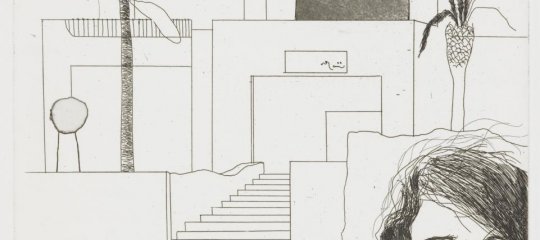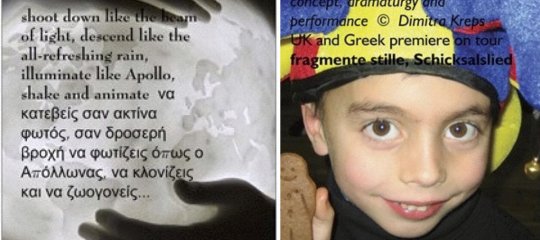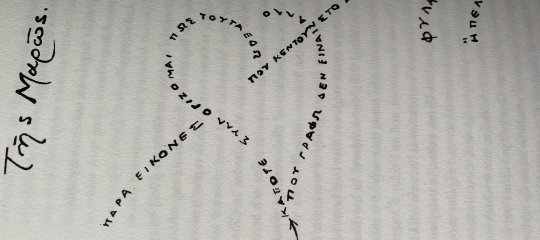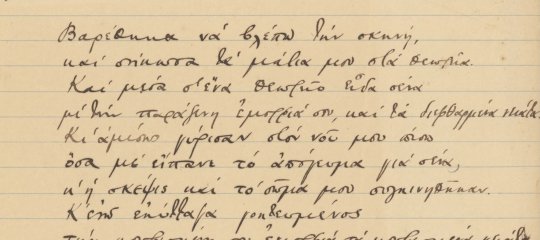Συνέδριο νέων επιστημόνων
MihalisPatsis writes, "
Παραθέτω το πρόγραμμα του έκτου συνεδρίου των νέων επιστημόνων που έγινε στο Λομονόσοφ τον Απρίλιο, για ενημέρωση αλλά και για πληρέστερη γνωριμία με τις ελληνικές σπουδές στη Μόσχα και σε άλλες πόλεις της Ρωσίας.
"
25 Αυγούστου 2003
Νέοι επιστήμονες είναι οι φοιτητές και οι μεταπτυχιακοί φοιτητές. Στο συνέδριο συμμετείχαν και φοιτητές από άλλες πόλεις και σημειώνεται η πόλη, οι αναγραφόμενοι χωρίς πόλη είναι από τη Μόσχα.
Κρατικό Πανεπιστήμιο της Μόσχας. Μ.Β.Λομονόσοφ
Φιλολογική Σχολή
Τομέας της Βυζαντινής και Νεοελληνικής Φιλολογίας
6ο Διεθνές Συνέδριο νέων επιστημόνων στις Βυζαντινές και Νεοελληνικές Σπουδές
Μόσχα 11-13 Απριλίου 2003
Παρασκευή 11.04.03
«Γλώσσα, ιστορία και κουλτούρα στο Βυζάντιο»
Νιτσάεβα, Ε.Η. (Αγία Πετρούπολη): Πρέσβεις-κατάσκοποι την εποχή της ύστερης αρχαιότητας.
Εβντοκίμοβα Α.Α. : ‘Ο Ιωσήφ Προσεύχεται στον Κύριο’ ... η ιστορία ενός κειμένου.
Εσέενκο Ν.Σ. (Αγία Πετρούπολη): Η μορφή του Ιουδαίου στην πολεμική των εικονομάχων και των εικονολατρών.
Ζαβιάλοβα Β.Σ.: Ο Πλούταρχος στο Βυζάντιο.
Μακάροφ Ντ.Ι. (Αικατερίνεμπουργκ): Από την ιστορία της εκκλησιαστικής ορολογίας στην βυζαντινή ρητορική της γιορτής της Μεταμόρφωσης.
Ποσπέλοφ Α.: Λόγοι αγαπητικού καημού και πάθους προς τον Κύριο στους ‘Ύμνους’ του Αγίου Συμεών του Νέου Θεολόγου (11ος αιώνας)
Τσιαστιακόβα Β.Β. (Αγία Πετρούπολη) : Ο Ψελλός στις νεότερες βυζαντινές σπουδές, (για το βιβλίο του Ε. Καλντέλη ‘The argument of Psellos –Chronografia’)
Πατιόχινα Α.Α.: Τεκμηρίωση του χριστιανικού θαύματος μέσω του ειδωλολατρικού στην πραγματεία του Ψελλού ‘Λόγος για το Θαύμα στο Ναό των Βλαχερνών’.
Σκριπατσένκο Γ.Ε. (Κίεβο): Από την βυζαντινή αγιογραφία στα θαύματα και τα επιτεύγματα του Αγίου Σάββα του Σέρβου.
Βόλκοβα Ν. (Αγία Πετρούπολη): Η σημασία του ρήματος "ειρωνεύομαι" στην ‘Ιστορία των Ρωμιών’ του Νικηφόρου Γρηγορά.
Μπογκντανόφσκι Α.Σ.: Η γλώσσα του βυζαντινού μυθιστορήματος ‘Βέλθανθρος και Χρυσάντζα’. Γλωσσάρι - Λεξιλόγιο.
Χαριτόνοβα Μ.Α.: Ο Μάξιμος ο Γραικός και η σλαβική μετάφραση της Επιστολής του Πατριάρχη Φώτιου στον βούλγαρο ηγεμόνα Βόρις.
Νεστέροβα Ε.Α.: Μεταφραστές της ελληνικής, στο υπουργείο Εξωτερικών της Ρωσίας, το δεύτερο μισό του 17ου αιώνα.
Αφτσαρόβα Ο.Β.: Ο ναός του Αγ. Παντελεήμονα στο Νέρζ. Πρόταση για ερμηνεία της διάταξης των τοιχογραφιών.
Σβερντλόβα Σ.Β.: Οι τοιχογραφίες του Ναού στο Ιβάνοβο της Βουλγαρίας (14ος αιων.)
Ζαχάροβα Α.Β.: Η εικονογράφηση των μικρών Ευαγγελίων στο Μεσαίωνα.
Σάββατο 12.04.03
Ελληνική Λαογραφία και Εθνογλωσσολογία.
Μπακούλεβα Ο.Α.: Ο φυτικός κόσμος στα ελληνικά δημοτικά τραγούδια της ξενιτιάς.
Σίντνεβα Σ.Α.: Ο συμβολισμός των φυτών στο ελληνικό παραμύθι.
Αγκαφάνοβα Ντ.Β.: Τα ελληνικά νανουρίσματα.
Πονομαριένκο Ξ.Α.: Τι είναι οι Δρίμες ή Δρίματα.
Νεοελληνική Λογοτεχνία
Φέντινα Ο.Α.: H ελληνική ρίμα τον 17ο αιώνα στο παράδειγμα της «Κυπριακής Συλλογής».
Μουράτοβα Α.Ν.: Ο Γρ. Ξενόπουλος και η επιρροή της Ζακύνθου στο έργο του.
Γκαρασίμοβα Ο.Β.: Τα θέματα της πατρίδας και της ξενιτιάς στο διήγημα του Γ. Βιζυηνού «Μοσκώφ Σελήμ».
Σαρτόρι Ε.Α.: Ο ελληνικός μοντερνισμός σε αναζήτηση παράδοσης (στο παράδειγμα του περιοδικού «Το Τρίτο Μάτι»).
Κούζινα Τ.Ο.: Οι Ιδέες και τα θέματα στο έργο του Γ. Ιωάννου.
Ζαρκάγια Α.: Οι σχέσεις των ηρώων στο έργο του Γ. Χειμωνά ‘Τα ταξίδια μου’.
Νοχοβάτκο Α.Α.: Η επιρροή του Γ. Χορτάτση στην ποίηση του Χ.Χ. αιώνα.
Ζαβιάλοβα Β.Σ.: ‘Μεγάλοι’ και παιδιά στο μυθιστόρημα ‘Με το παράξενο όνομα Ραμάνθις Ερέβους’.
Μπάναχ Λ.Σ. (Συμφερόπολη): Η χρήση των κοινωνικών ιδιολέκτων στο έργα των σύγχρονων ελλήνων πεζογράφων.
Κυριακή 13.04.03.
Νεοελληνική γλώσσα
Εβντοκίμοβα Α.Α.: Η έννοια της αιτίας στις ρηματικές φράσεις της νεοελληνικής. Τοποθέτηση του προβλήματος.
Αμπντραχμάνοβα Ντ.Α. (Αγία Πετρούπολη): Η διαμόρφωση του γραμμήματος (;) (grammem) του Μέλλοντα στη νεοελληνική.
Αβίνσκαγια Α.Β. (Αγ. Πετρούπολη): Η ιδιαιτερότητα της κατάστασης της νεοελληνικής και τα προβλήματα που συνδέονται με τη διδασκαλία της ελληνικής ως ξένης.
Ζαμπέλινα Σ.Α. (Αγ.Πετρούπολη): Το πρόβλημα της διαμόρφωσης της νόρμας της νεοελληνικής σε συγκριτικό υλικό των λεξικών Μ.Τριανταφυλλιδή και Γ. Μπαμπινιώτη.
Μπέλοφ Ν.Ν. (Αγία Πετρούπολη): Η κυπριακή διάλεκτος τον 15ο αιώνα (με βάση υλικό από τη ‘Χρονογραφία’ του Μαχαίρα).
Νικολαένκοβα Ο.Ν. (Αγία Πετρούπολη): Προβλήματα ουρανικοποίησης , ανομοίωσης και αφομοίωσης στα μικρασιατικά ιδιώματα.
Φένττσενκο Β.Β. (Αγ. Πετρούπολη): Τα τουρκικά δάνεια στη διάλεκτο της Μαριούπολης της Νέας Ελληνικής.
Μ.Πάτσης Λομονόσοφ
- Εισέλθετε στο σύστημα για να υποβάλετε σχόλια










